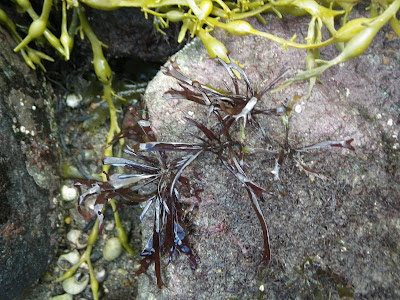Rock pooling destination: Western
Isles, Elean Siaris, The Hebrides, June 2012
 |
Rocky Shore - Lichens dominate the uppermost shore, whilst fucoids
occur throughout the mid to lower shore. Habitat classification: LR.FLR.Lic (Lichens on supralittoral and littoral fringe rock) and LR.LLR.F (Fucoids on sheltered marine shores). |
The rocky shore is comprised of cobbles and
boulders that are colonised by lichens in the uppermost shore and fucoid
seaweeds from the mid to lower shore. Most marine organisms are aggregated
beneath the fucoid understory and boulders.
Lichens grow on the rocks of the uppermost shore, interspersed
with occasional clumps of sea thrift, in what is known as the ‘splash zone’.
Fucoid seaweeds dominate
the mid to lower shore, exhibiting zonation, with specific species dominating
bands of the shore.
Channelled wrack (Pelvitia canaliculata) is found first, where it co-occurs with the lichen Verrucaria Maura and occasional bladder wrack (Fucus vesiculosus), rough periwinkles (Littorina saxatilis) and barnacles.
 |
Channel wrack (Pelvetia canaliculata) and the tar lichen (Verrucaria maura).
Habitat classification: LR.LLR.F.Pel (Pelvetia canaliculata on sheltered littoral fringe rock) |
Egg wrack (Ascophyllum nodosum) forms blankets across the mid to lower shore. Underneath which other seaweeds including bladder wrack (Fucus vesiculosus) and smaller red, brown and green seaweeds grow. Limpets, winkles and whelks occur among the fronds and under the boulders are tunicates, sponges, polychaetes, byrozoans, hydrozoans, echinoderms, crustaceans and anemones.
 |
Egg wrack (Ascophyllum nodosum).
Habitat classification: LR.LLR.F.Asc (Ascophyllum nodosum on very sheltered mid eulittoral rock)
|
As the low tide mark is reached the boulders give way to sediment. Serrated wrack (Fucus serratus), Ulva Spp and other membranous red and brown seaweeds come to dominate and amongst these a seasonal aggregation of sea hares had occured.
 |
| LR.LLR.F (Fucus serratus on sheltered eulittoral rock) |
Below are images of some of the marine organims encountered in the different habitats of this rocky shore:
 |
| Sea thirft amongst Lichen in the 'splash zone' |
 |
| Strawberry anemone (Actinia fragacea). |





































































